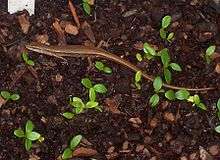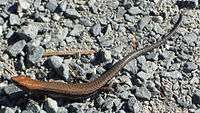Lampropholis delicata
The delicate skink,[2] dark-flecked garden sun skink,[3] garden skink or plague skink[4] (Lampropholis delicata) is a skink of the subfamily Lygosominae, originally from Eastern Australia. In its native range, and in New Zealand, it is also known as the rainbow skink, a term that usually refers to the African Trachylepis margaritifera, also a member of the Lygosominae.
| Lampropholis delicata | |
|---|---|
 | |
| Scientific classification | |
| Kingdom: | Animalia |
| Phylum: | Chordata |
| Class: | Reptilia |
| Order: | Squamata |
| Family: | Scincidae |
| Genus: | Lampropholis |
| Species: | L. delicata |
| Binomial name | |
| Lampropholis delicata (De Vis, 1888) | |
The delicate skink is more common in suburban gardens than in adjacent native bushland. It has a moderate body with a medium length, slender tail. Its scales are smooth. The back and sides are greyish-brown to rich brown, often with darker and paler flecks. A narrow yellowish-brown stripe is usually present on the outer edge of the back. The species can also have two distinct forms: a prominent white stripe and a less prominent white stripe. This dimorphism is not strictly distinguished by gender.[5]
It was accidentally introduced to New Zealand in the early 1960s and is now found in several parts of the North Island,[6] where it is considered an invasive species as they compete with native lizards and mammals for food and habitat.[4] It has also become naturalized in Hawaii, where it is reportedly now the most numerous skink, and on Lord Howe Island.[7]
Color dimorphism
Individuals of the Lampropholis delicata species have a distinct color dimorphism.[5] As of now, two morphs are known: a prominent white stripe and absence of the stripe along the lateral to midsection of the body.[5] However, expression of the stripe is reduced in males, so that the stripe in males is dull compared to striped females. The continuation of each morph is often linked to its fitness advantage in crypsis but varies for each sex and temperature exposure.[5] The presence of the stripe can confer a fitness advantage in females but in males the coloration may cause exposure to predation therefore males are far more commonly plain than striped and their stripe is less distinct.[5] However the ultimate cause of this color dimorphism is not entirely conclusive for each sex but may be attributed geographical distribution, natural barriers, habitat preference, and sexual selection.[5]
Since the Lampropholis delicata species is not native to the area in which they are found, it is possible that the resulting morphs are caused by the exposure to a new environment and climate as this particular species' activity level is temperature dependent.[5] The most active males are found in lower temperature microhabitats and display a higher number of individuals with indistinct stripes.[5] This could be a result of anti-predation tactics.[5] Females of this species do not display the same activity level as their male counterparts so the number of females with the less distinct morphs remain lower.[5] Sexual selection also plays a role on the continuation of this dimorphism because females seem to choose the males with higher fitness traits, in this case they favor the highly active less distinct striped males.[5]
Aside from the variation in climate, Eastern Australia also provides different ground cover substrates as potential habitats. The species prefers an open substrate environment because the ground cover and loose leaf litter allows for thermoregulation, protection and optimal foraging conditions.[8] Females and males remain sheltered in the leaf litter and their cryptic coloration adds an additional camouflage element but it is inconclusive as to whether the habitat distribution directly caused the color dimorphism.[9]
Environmental factors greatly influence the change within the Lampropholis delicata species and continue to preserve each distinct variation. These polymorphisms have the potential to greatly affect survival in each niche, especially because the Lampropholis delicata is an invasive species, creating more need for adaptations.[10]
Gallery
 Naturalised rainbow skink in Raglan, New Zealand
Naturalised rainbow skink in Raglan, New Zealand Note the yellowish stripe on the side.
Note the yellowish stripe on the side.
References
- Chapple, D.C, Shea, G., Dickman, C., Wilson, S., Hobson, R. & Sanderson, C. 2018. Lampropholis delicata . The IUCN Red List of Threatened Species 2018: e.T109473102A109473141. https://dx.doi.org/10.2305/IUCN.UK.2018-1.RLTS.T109473102A109473141.en. Downloaded on 09 March 2020.
- A new genus and a new species of skink from Victoria
- Lampropholis delicata Archived 2009-10-12 at the Wayback Machine, James Cook University
- "Plague skinks". Department of Conservation, New Zealand. Retrieved 16 October 2015.
- Forsman, A. and Shine, R. (1995), "The adaptive significance of colour pattern polymorphism in the Australian scincid lizard Lampropholis delicata". Biological Journal of the Linnean Society, 55: 273–291.
- Joanne E. Peace (2004). Distribution, habitat use, breeding and behavioural ecology of rainbow skinks (Lampropholis delicata) in New Zealand Archived 2012-03-03 at the Wayback Machine, MSc thesis, Massey University. Retrieved 3 September 2010.
- Christopher Lever (2003). Naturalized reptiles and amphibians of the world, p. 101. Oxford University Press. ISBN 978-0-19-850771-0.
- Peace, Joanne E. Distribution, habitat use, breeding and behavioural ecology of rainbow skinks (Lampropholis delicata) in New Zealand. Diss. Biological Sciences)--University of Auckland, 2004.
- Robert Howard, Ian Williamson and Peter Mather, "Structural Aspects of Microhabitat Selection by the Skink Lampropholis delicata", Journal of Herpetology, Vol. 37, No. 3 (Sep., 2003), pp. 613-617, https://www.jstor.org/stable/1566074?seq=3#page_scan_tab_contents
- Leimar, Olof, 2009 Environmental and genetic cues in the evolution of phenotypic polymorphism. 23: 125-135
Further reading
- A Complete Guide to Reptiles of Australia - Steve Wilson & Gerry Swan ISBN 1-876334-72-X
- Lampropholis delicata, Parks and Wildlife Service, Tasmania
